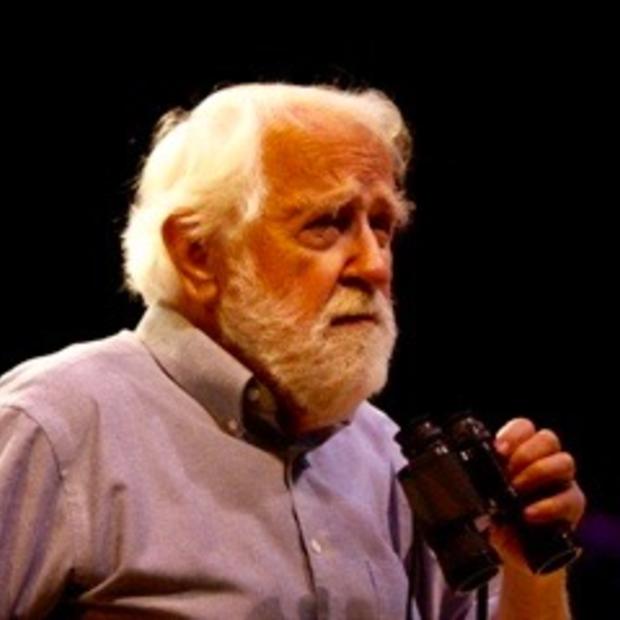It’s a crystal September morning with a light sea breeze. The tide is running in, and a million pink salmon are rounding Lummi Island's Legoe Bay, west of Bellingham, heading for the Fraser River. In the middle of the run, facing into the flood tide about a quarter mile offshore, sits a little fleet of small boats with sturdy towers. Fishermen stand atop them, keeping their eyes peeled for schools of salmon.
It’s an image out of its time, a throwback to a period thousands of years ago when the people of Washington’s north coast prospered by reefnet fishing. It’s also a picture to be framed and hung in the gallery of things-that-remain-remarkable about the Northwest. This is the only reefnet fishery in the world, as far as its practitioners know, and the way it works is a marvel.
Two boats and the net between them comprise a “gear” in reefnet parlance. The gear's crew — four members on one boat, one on the other — have laid out a pair of long floating lines, roughly parallel, one behind each boat. Streamers of various colors dangle from the lines, forming an avenue that must look — to a fish's eye — something like the seascape along a reef. The streamers fool the fish into behaving as though this were a natural reef: They swim up it and into a net strung about 25 feet below the surface.
Suddenly there’s whooping and hollering and the screech of battery-powered winches. The net rises, sagging and bulging with fish. Dave Hansen and Ian Kirouac drop from the spotting stands to join Angie Kubalek and Josh Thomason at the low, steel surfaced loading deck. They paw frantically, hand over hand, at the heavy net. Finally just one pocket remains — the payoff, a mass of squirming, flopping and altogether gorgeous bright salmon. The catch can vary from a few dozen to as many as 200 fish.
As they come aboard, the salmon roll over the edge of the boat and slide into its sea-well, a rectangular hole lined with netting. Kubalek, an attractive, athletic Evergreen College graduate from Lincoln, Nebraska, reaches into the well barehanded and hauls out the biggest of the fish. It’s a wild king, a prized, endangered chinook. Kubalek gently releases the fish into the open water. She turns back to the well and hoists a wild sockeye, sliding it into the open water as well. Throughout the day the crewmembers scan their take, watching for forbidden fish that are out of season or protected species.
“There you have one difference between reefnetting and the other ways of taking fish,” Kirouac observes as we squeeze into the narrow one-person stand atop the tower. “We return those fish alive and healthy. They hardly know they’ve been caught. You can’t do that if you’re gillnetting or purse seining. We know that as much as 60 percent of what they haul up is bycatch, fish they have to return. By the time they sort out the bycatch and throw them back they’ve been out of the water and flopping around on the deck for some time. Their bycatch is dead or dying. Ours is alive and healthy.”
The fish remain alive and swimming in the sea-well until the crew lifts them out, one at a time, bleeds them with a cut in the gills, and drops them into a smaller well to die in the water. Then they’re transferred, singly and carefully, into tubs of slush ice on a small powerboat and carried to a nearby tender, a large ship where a fish buyer awaits.
Peculiar though it is, reefnetting is not something contrived by fish-huggers to show the tourists how it used to be done. It is nearly as humane as one could imagine fishing to be, but there are other motives behind it. The members of the Lummi Wild Fishing Cooperative are in business to make a living, same as any gillnetter, purse seiner or ocean trawler. It’s just that they want to do it in a way that produces the least abused and therefore best-tasting salmon possible, with the least collateral damage to protected species. Reefnet fish bring a premium – sometimes nearly twice the price of fish handled conventionally – as they head for the white tablecloths of upscale restaurants and the pricey seafood sections of Haggens and WholeFoods.
On this day we’re fishing a hundred feet or so from the Granger gear, operated by the third generation of Granger family reefnetters on Lummi Island. It looks like they got hold of a fish magnet today; they haul netload after netload of pinks aboard, with jubilant shouts and whistles. They seem to take two hauls to every one managed by the gear on either side. “My gosh, look at that, that’s awful!” Dave Hansen shouts goodnaturedly. “They’re humiliating us!”
Jim Jensen, fishing between our gear and the shoreline, has tied a broom to his tower with the sweeping end pointed at the sky. It tells the small world of Legoe Bay and Lummi Island that his gear has broken its all-time record, hauling in 102,000 pounds of salmon so far in this dwindling season.
Thursday is the end of it, for now; the season for pinks is over. Josh Thomason thinks he might go back to college. Angie Kubalek worked on a National Science Foundation study in Antarctica last year and thinks she might do it again this winter. Ian Kirouac will oversee Lummi Island Wild’s website. He and Dave Hansen will work to introduce their special salmon to buyers’ clubs and food stores all over the country, until the coho start running for the Fraser River in October.
Then they'll return to their towers, squinting into the sea, searching for salmon along an ancient underwater trail.
Can Washington state fit shipping coal to China with protecting fish?


